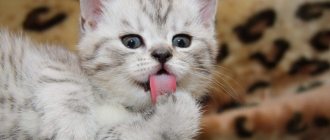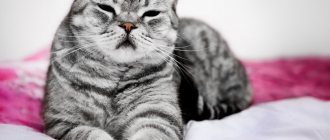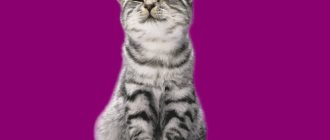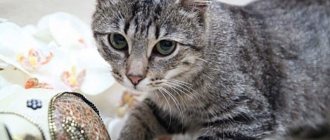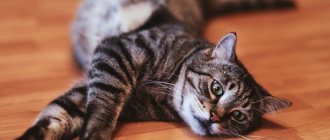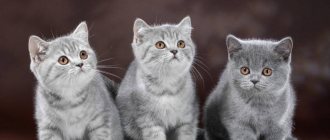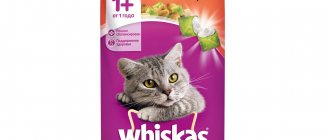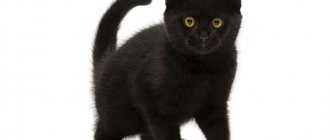WCF breed standards
| Weight | From 2.6 to 6 kg. Female cats have a lower body weight than female cats. |
| Appearance | Average height. Strong, stocky and massive constitution. Movements are confident and smooth. |
| Temperament | |
| Torso | Short, rounded and squat. |
| Head | Large, with thick cheeks and a strong chin. Large round whisker pads. |
| Muzzle | Round. |
| Chin | Strong. |
| Eyes | Large, round. Eye color matches coat color. In the USA and European countries you can see folds with orange, copper and golden eyes. |
| Ears | Small, pressed tightly to the head, with a characteristic fold. Set wide apart, directed towards the center of the head. The tips of the ears are rounded. |
| Nose | Short, wide, straight. Profile without stop. |
| Neck | Short and thick. |
| Frame | Compact |
| Wool | Short, thick, soft, shiny and elastic. Has high density. The texture is fleecy, but not woolly. |
| Color | All colors and patterns with any amount of white: plain (solid), “Chinchilla”, “Tabby”, “Calico”, “Bicolor”. |
| Limbs | Short, muscular. |
| Paws | Round and thick. |
| Tail | Medium length, flexible, reaching to the shoulders. It ends with a rounded tip without thickening. |
| Defects |
|
Plain (solid, solid)
The monochrome uniform coloring of Scottish cats is considered classic by breeders.
The solid or solid color of the animal implies the absolute exclusion of any inclusions, small marks and specks of a different color. The tone is rich, even along the entire length of the coat. The most common used to be considered blue plain Scots. But today among the representatives of the breed there are many other variants of solid colors.
White
A Scottish cat with snow-white fur (without yellowness) looks luxurious. Possible eye colors are blue, amber, copper. According to the standard, eyes of different colors are allowed. The paw pads and nose are light pink.
Kittens may have markings of a different shade, which disappear after the first coat change. By the age of two, the coat of a white Scot should be crystal clear, without spots of a different color.
Black
The black cat has expressive yellow eyes. The nose and paw pads practically blend into the main color of the animal.
On the shiny bright coat of the Scottish beauty Ebony, 2-3 hairs of contrasting white color are allowed. The presence of large red or brown marks is not provided for by the standard.
Chocolate
The brown Scottish cat, also called chocolate, looks noble and impressive. The color of the coat contrasts with the animal's yellow, golden or copper eyes. The nose and paw pads are also dark brown.
Lilac (lavender)
The monochromatic lilac Scottish Fold has a gentle gray tint that smoothly turns into cream. The nose is slightly brownish, the paws on the bottom are the same color as the coat, in harmony with the main color of the pet. This lilac-lavender color goes well with eyes of copper, amber or orange shades.
Red (red)
Red or ginger color is a rare and valuable color of the Scots breed. The fiery edge is combined with burning amber irises. Pads and nose to match the dominant color.
The tail of kittens and adult animals is not very evenly colored. This deficiency does not disappear with age and is allowed by the standard. And the presence of marks on the head and limbs that remain after reaching the age of two are considered a deviation from the norm.
A red Scottish straight-eared cat can give birth to kittens not only with erect ears, but also with ears pressed to the head.
Cream
The cream or peach fold cat is infinitely elegant and beautiful. The delicate background of light fur, bright golden eyes and a pinkish nose give the pet an irresistible appearance. The pads on the paws are also pink. An animal with this color is similar to a red Scotsman, but its coat color is a shade lighter.
A peach fold kitten may have a blurry, fuzzy pattern on its paws and tail that does not disappear with age. This is not critical for a purebred pet, but leopard markings are absolutely unacceptable.
Faun (deer)
There is another unique color of Scottish fold cats with an interesting name - fawn, which means “young deer”. The nose and pads on the paws of these beauties are beige-pink.
Cinnamon
Cinnamon is a lighter and more delicate color than chocolate, but darker than red. The nose and paw pads of such animals are brown, beige or pink.
Blue color (blue)
The gray or blue Scottish cat has very beautiful amber eyes. The coat tone of a purebred pet can belong to any range of gray - from the lightest (blue) to completely dark (blue). At the same time, each hair is saturated and well colored, without streaks.
The nose and pads practically do not differ in color from the plain coat.
A gray Scottish Straight cat may be marked with a few streaks and drawings in childhood. But as they grow older, these color flaws go away.
British Whiskas cats: types of colors
In British Whiskey cats, the main tone is silver, but the pattern can be made in different coat colors. The colors of British silver tabby cats are encoded with the letter s (silver), which is added after the main color of the color.
Whiskey British (British silver tabby) can be of the following types:
- black silver ticked/spotted/striped/marbled BRI ns 25/24/23/22;
- blue silver black silver ticked/spotted/striped/marbled BRI as 25/24/23/22;
- lilac silver black silver ticked/spotted/striped/marbled BRI cs 25/24/23/22;
- chocolate silver black silver ticked/spotted/striped/marbled BRI bs 25/24/23/22;
- cinnamon silver black silver ticked/spotted/striped/marbled BRI os 25/24/23/22;
- fawn silver black silver ticked/spotted/striped/marbled BRI ps 25/24/23/22;
- red silver black silver ticked/spotted/striped/marbled BRI ds 25/24/23/22;
- cream silver black silver ticked/spotted/striped/marbled BRI es 25/24/23/22;
- tortoiseshell silver ticked/spotted/striped/marbled BRI 25/24/23/22;
- bicolor silver ticked/spotted/striped/marbled BRI 25/24/23/22;
- silver color points ticked/spotted/striped/marbled BRI 25/24/23/22.
British kittens of Whiskas color
British Whiskas kittens can only be born from parents of this color or carriers of this color. A British Whiskas (silver tabby/tabby) kitten should have a fairly contrasting pattern from birth. It must be remembered that over time, the color of Whiskey British cats “erodes” as the kitten grows, so, for example, a tabby can turn into a spotted color. The completely silver tabby color (whiskey) of British cats is formed by one year.
| In our cattery you can “buy a real British kitten.” We have many different colors, we will help you choose and answer all your questions! |
Other breeds that have this color
In addition to British cats, other varieties have colors similar to Whiskas.
| Breed | Short description | |
| Scottish Fold or Scottish Fold | Scottish kittens are in many ways similar to their British counterparts, differing from them only in small ears curved inward and a narrower muzzle. Representatives with brindle color have vertical narrow stripes, a striped pattern on the tail, and the letter “M” on the forehead. The eyes and nose are outlined with a dark line | |
| Siberian | The common coloring of this breed is Siberian brindle tabby with thin, clear lines running from the back to the belly. There is also a torby color, in which silver, chocolate or blue brindle is combined with cream spots | |
| Persian | The striped color of the Persians is called the “patchwork pattern.” Characterized by narrow lines, paws and tail in bracelets and chains on the chest | |
| Maine Coon | Cats of this breed often have patterned colors. Among them there are also striped ones, the most popular of which are red and silver brindle |
The cat from the Whiskas advertisement
The popular video featured a breed of cat called the British Shorthair with a brindle tabby color on a silver background. However, the British are not only whiskey drinkers. There are various shades - plain black, blue, white, as well as brindle, spotted, marble. Close “relatives” of the British cat are the Scottish Straight and the silver chinchilla. Scottish fold kittens also come in silver color with a black pattern, but are not related to the advertising prototype. In general, the “Whiskas” breed does not exist, it’s just the name given to cats that look like furry actors who have become the “face” of a popular brand.
Character and behavioral characteristics
Even in one litter you will not find two kittens with the same character. One may behave very impulsively and even aggressively, another will be gentle and affectionate, and the third will be overly inquisitive. However, there are character traits that characterize almost all Scottish Fold cats. The description of the breed confirms that these are temperamental animals, ready to make contact with humans. And that his character will depend on his upbringing.
The Scottish Fold is different:
- a highly developed sense of independence - there are even egoists among them;
- selective memory - the cat learns only that information that is interesting to it and will bring benefits;
- awareness of personal significance and increased self-esteem - she will not tolerate a bad attitude towards herself, and if something happens, she will also take revenge on the offender by making a puddle in her favorite shoes;
- unobtrusiveness - this is not a breed that will seek the owner’s attention at any cost;
- moderate playfulness - loves outdoor games, especially if the beloved owner participates in them;
- dislike of fights - the purr does not instigate quarrels and conflicts, he prefers to leave the conflict zone;
- good hunting qualities - moves quickly and always takes its prey by surprise;
- patience - ready to wait for hours for prey in a secluded place;
- excellent sense of day and night - they prefer to follow a certain regime and do not like to deviate from it;
- with a pronounced reflex of tameness - they become attached to both the person and the place of residence.
Pets don't like change. They get used to their new home pretty quickly. Moving is always associated with stress for them. A well-studied environment helps the cat navigate in space. Pets can be sensitive to even the rearrangement of furniture, and even more so the redevelopment of a well-known house, which, with their characteristic selfishness, they consider their property.
The Scottish Fold is an exclusively domestic cat. She feels great in an apartment or house. But from time to time you can take her out for a walk.
Other breeds of blue screen star cats
Ocicat cat - description of the cat breed, red kitten
“British” and “Scots” are far from the only TV stars. For example, the face of the advertising campaign for Gourmet Gold food is a white Persian cat, and Sheba is represented by an elegant Russian blue cat. But to become a screen star, you don’t have to belong to any particular breed. The well-known cat Boris from the Kitiket advertisement is a mongrel, just like the ginger cat from the Friskies commercials.
Advertising is one of the most important aspects of the success of any brand. But sometimes it brings not only fame to the company, but also an advertising hero. A striking example of this is the Whiskas advertising campaign, which popularized British and Scottish Shorthair kittens. Everyone dreams of having such a pet. The main thing is to accurately determine the breed and color.
Colors of Scottish cats: photos, table, descriptions
If you ask the average person what color Scottish cats are, he will certainly answer that they are gray (the color among professionals is called blue). This is a common color of Scottish cats. But today the variety of colors is very large. Therefore, when asked what color Scottish cats are, you must boldly answer: any! To get such a wide palette, Scots had to be crossed with other breeds. Today, interbreeding is not encouraged, because cats already have the necessary set of genes.
In Scottish cats, two genes predominate, responsible for black and red coat colors. Each of them can act as a dominant (suppressing weaker genes) and recessive (suppressed gene). And there is a third diluent gene, responsible for the saturation of the pigment. Combining in a certain order, these genes can give completely unimaginable coloring. If you are interested in the topic of the genetics of the colors of Scottish cats and what coloring results from crossing, come here. And we will continue.
The presence of one color or another in a Scottish kitten cannot always be determined in the first weeks of life. This is not the final shade yet, because the coloring becomes brighter and more pronounced only when the coat is replaced by an adult during the baby's molt. This happens around six months of age. But up to 2 years, the shade may still change slightly.
Scottish cat color chart
Cats of the Scottish breed (Scottish Fold, Highland Fold, Scottish Straight and Highland Straight) are subject to the international color classification. It has symbols - numbers and letters. The code consists of:
1. Capital letters denoting the breed.
2. Lowercase letters indicating the primary color (blue, chocolate, etc.).
3. Pairs of numbers indicating the type of color (shaded, harlequin, Siamese, etc.) are numbers from 1 to 35.
4. Tail length - numbers from 51 to 54.
5. Eye color - numbers from 61 to 67.
6. Another additional pair of numbers can indicate the shape of the ears - 71 (straight ears of the Scottish Straight) and 73 (dropping and forward-curved ears of the Scottish Fold).
XXX.xx.NN.NN.NN.(NN)
xx - lowercase letter color designations:
| Designation | Colors |
| A | blue |
| b | chocolate, brown, chestnut (chocolate, brown, Havana, champagne) |
| With | lilac, lavender (lilac, lavender, platinum) |
| d | red, flame (red) |
| e | cream (cream) |
| f | tortoiseshell, patch (tortoiseshell) |
| g | blue-cream, blue-tortie (blue cream, blue tortoiseshell) |
| h | chocolate-tortie (chocolate tortoiseshell) |
| j | lilac-tortie (lilac tortoiseshell) |
| n | black, ebony, seal, sable, ruddy (black, ebony, seal, sable, wild) |
| o | sorrel, cinnamon, honey (sorrel, cinnamon, honey) |
| p | beige fawn (yellow-brown, beige) |
| q | sorrel tortie (red-brown tortoiseshell) |
| r | beige fawn tortie (beige tortoiseshell) |
| s | silver, smoke (silver, smoky) |
| w | white (white) |
| x | unregistered (unregistered color) |
| y | golden (golden) |
NN.NN.NN.(NN) - values of pairs of digits (up to three main and one auxiliary), starting with 0:
| Designation | Decoding |
| 01 | van (van) |
| 02 | harlequin (harlequin) |
| 03 | bicolour (two-color, bicolor) |
| 04 | mitted/white point (with white markings for color points) |
| 09 | little white spots (white spotting 1-2 cm) |
starting with 1:
| Designation | Decoding |
| 11 | shaded (shaded, i.e. 1/4 of the top part of the hair is darkened) |
| 12 | tipped, shell (veiled, i.e. 1/8 of the top part of the hair is darkened) |
starting with 2:
| Designation | Decoding |
| 21 | tabby, agouti (striation, agouti factor) |
| 22 | blotched, marble |
| 23 | mackerel, tiger (mackerel, tiger) |
| 24 | spotted (spotted) |
| 25 | ticked (ticked or Abyssinian) |
starting with 3:
| Designation | Decoding |
| 31 | burmese (Burmese) |
| 32 | tonkinese (Tonkinese) |
| 33 | himalayan or siam (Himalayan, Siamese, point) |
| 34 | singapura (Singaporean) |
| 35 | abyssinian (Abyssinian) |
starting with 6 (eye color):
| Designation | Decoding |
| 61 | blue |
| 62 | yellow, golden (yellow, orange, golden) |
| 63 | oddeyed |
| 64 | green |
| 65 | burmese (eye color of Burmese cats) |
| 66 | tonkinese (eye color of Tonkinese cats) |
| 67 | himalayan or siam (eye color of Himalayan and Siamese cats) |
For example, a fold-eared cat of color ps 24 is a cat of silver spotted fawn color. Thus, as you can see, the color code is formed from letters and numbers, but there are a lot of variations in the colors of Scottish breed cats, because... various factors combine to form countless variations. Within the scope of this article it is impossible to show absolutely all the colors of Scottish cats, cats and kittens.
Acquaintance
So, I won’t bother you with a long wait, and... drum roll: the cat from the Whiskas ad is a British Shorthair. Today, all over the world, British cats are considered the most popular.
The cats, or rather the kittens from the commercial, were born and raised in Germany in a nursery called “Silver Treasure”. The kittens of this nursery have become recognizable since 2003. Can you imagine how much time has already passed? But it was the British with the “silver tabby” color that viewers fell in love with. You can often find the color “brindle” or “merle tabby”. A breed with this color is considered new, bred by pet lovers, not by felinologists. It is noteworthy that in recent years a characteristic feature has been the naming of a cat’s breed after the name of the food it advertises.
Having learned what breed of cat is in the Whiskas advertisement, many people rush headlong to buy it. But first you should find out the prices. Thoroughbred British are unlikely to be handed over to “good hands” for free. Imagine, the cost of a kitten from a commercial (not the same one, but a similar one) varies between 25-100 dollars. Purebred young pets with a rare color can cost about 250-350 dollars.
Why did British Shorthairs win the tender to appear in the Whiskas commercial?
The cat from the Whiskas advertisement is the face of the brand. Why was this breed given such honor? Everything is so banal. When a TV viewer sees such a baby, he understands that the “British” is the personification of an ideal (in every sense) pet: so calm, sweet, balanced, well-groomed and unrivaled. This breed is capable of unbalancing (in a good way) even the most unemotional and secretive person: you just want to cuddle the baby.
The British Shorthair breed was chosen because it has the following qualities:
- ideal composition, harmony and proportionality of the body;
- dense and thick tabby coat resembles a plush blanket;
- adult Scottish Straight animals and kittens are equally attractive to television viewers;
- absence of signs indicating the exclusivity of the breed.
As already mentioned, representatives of the breed for advertising are raised in a German nursery. The key to success is to comply with the following laws:
- good heredity;
- proper care;
- balanced, proper nutrition;
- constant examination by veterinarians;
- natural selection.
Only by complying with the above standards do breeders raise energetic, attractive, healthy pets. Moreover, kittens with the most touching and sweet faces are selected for advertising.
Features of British Shorthair
The history of coexistence between humans and British shorthair cats stretches back to time immemorial. It was precisely these years of strength testing that made the “British” both an excellent hunter and a loving pet.
Scottish Terrier: description of the Scottish breed
They are quite unpretentious and only need sufficient communication and attention from the owner. The character is calm and flexible. Their fur is not long, and the thick undercoat makes the animal look like a plush toy. The average hair length is 2.4 mm. The undercoat must be brushed regularly.
For your information! In terms of density and delicacy of a cat's fur, it can only be compared with the fur of a bear.
It’s not enough just to know the breed of the cat that took part in the commercial. Many people want to buy exactly the same one for themselves. And the breeds of cats that starred in the advertisements abound in a variety of colors and colors. This paragraph will provide detailed information about the color of the screen star cats.
Appearance of British cats
It is difficult to find a person who has never seen a British breed cat in his life. This is a fairly common breed that has long lived side by side with humans. The appearance of these animals sinks into people's souls.
An adult "British" is a medium-sized animal with short, dense fur. Because of its thick coat, even a very thin cat will look a little plump. A distinctive feature of British cats is a rounded muzzle with large large eyes and small ears, which can be erect or hanging. One of the most popular colors is gray, which is also called blue. The legs are short, but this does not prevent the British from looking very graceful and elegant.
Purebred British cat
The main colors of the British
As mentioned earlier, one of the most popular is the gray (blue) color. However, this is far from the only possible color of the skin of these cats.
- Solid colors. These include gray (blue), as well as rarer black, chocolate, lilac and white.
- Color point. A color in which the body is white or cream, and the face, ears, paws and tail are very darkened, almost black or dark brown. This color is often found in Siamese cats.
- Tortoiseshell. May be red and black or creamy blue. In this case, two colors cover the body in a chaotic pattern. The color ratio on the body should be 1:1.
- Smoky. In some individuals this color can easily be confused with a solid color. Smoky-colored cats have a white undercoat, and the tips of the hairs are very dark.
- Tabby. On the main light color of the body there are darker patterns in the form of stripes, spots or marbles. The spots are randomly located, just like the stripes. However, in the latter case, the letter “M” must be visible on the cat’s forehead, and clear dark lines must extend from the tips of the eyes.
Note! “British” “Whiskas” has a tabby color, or more precisely, a silver tabby.
Today, there are more than 62 official variations of the “British” colors. At the same time, at exhibitions, much attention is paid not only to the color of the coat, but also to the structure of the animal’s body.
Color of cats featured in Whiskas commercials
Several cats took part in the filming. They were united only by breed and color. Silver tabby cats won the hearts of the audience. They became associated exclusively with this brand of food.
Silver tabby cat
What does the British cat "Whiskas" look like?
All the cats in the ad looked the same. There are darker stripes on the light gray (silver) body. Eye color changed depending on the age of the cat. The fact is that all kittens up to a certain age have blue or gray eyes. The final color is determined only after several months of life.
It is noteworthy that the face of the company was chosen at Whiskas. The winners were cats of the Scottish Straight breed (British Shorthair). Their victory was brought about by a well-built, proportional body, an attractive, memorable color, as well as the absence of individual breed characteristics.
For your information! An interesting fact is that filming commercials has literally become a hereditary affair for the “Scots”. The first cat actor named Simba was born and raised in a German nursery. In 2003, he was approved for the main role in advertising. A few years later, his sons Chobi and Jesse also appeared in commercials.
Four more cats starred in videos from 2003 to 2007. Their names were Bailey, Chiara, Jamie and Sally. After them there was the kitten Shamu, who, according to the plot of the video, was looking for his mother.
Scottish fold kittens "Whiskas"
Kittens have always been an object of affection. Scottish Whiskas kittens can amaze anyone with their charm. The color of the kittens is the same - silver tabby. The only difference is that their ears are pressed tightly to the head, like all British Folds.
"Scottish" silver tabby color
Breeding
Breeding Scots should be left to breeders and nurseries. If pairs are crossed incorrectly, there is a high probability of getting sick offspring or animals whose defects will appear in the next generation.
Puberty
Maturity in animals occurs by the 8th month of life, however, a cat or male cat that has reached the age of 1.3 years is allowed to breed. Early pregnancy in animals leads to various birth complications, loss of litter, and reduced fertility.
Meeting with a partner
The cat meets her chosen partner on the second day of estrus, on the cat's territory. On the first day, the animals get to know each other, and skirmishes and conflicts are possible. The breeding partner must meet the WFC criteria to produce healthy offspring. To improve natural characteristics, animals of identical colors are mated; for example, you should not mix blue color with cinnamon, since in such cases the offspring are tortoiseshell in color, with heterochromia.
Mating of a fold-eared cat occurs only with Scottish Straight cats and, conversely, a fold-eared cat meets with a cat with erect ears. Sometimes it happens that fertilization does not occur after the first meeting of animals. It is advisable for the cat to stay with the cat for three days.
Pregnancy
Pregnancy in cats lasts nine weeks. The first signs appear in the second and third weeks. The nipples swell, change color, and the cat consumes a lot of food. During this period, it is necessary to exclude fish delicacies from the diet and add more fermented milk products, including natural yoghurts. In the fifth week, the cat’s belly is quite round, and the animal has gained significant weight. The entire period before the onset of labor, the cat behaves calmly and carefully.
Childbirth
Before the birth begins, the pet will begin to look for a place. It is quite possible that she will love an open closet or drawer. It is advisable to prepare a large cardboard box for the cat, lining it with a warm blanket or a thick layer of fabric. During childbirth, as a rule, outside help will only be needed to wipe the kittens from birth mucus and cleanse the sinuses, mouth and eyes. The cat will do the rest itself.
There are from 4 to 6 kittens in a litter. During the first days of life, the mother actively cares for and feeds them. At this time, you should not touch the cat or try to pet the kittens; the animal will respond with aggression. When the cat gets stronger, you need to take it to a doctor for an examination, and if any problems are detected, immediately begin their treatment.
Aftercare
As soon as the kittens reach one and a half months of age, the babies should be registered in the club. The establishment records all the characteristics of the kittens: gender, body size, color, and so on. Then you need to get a veterinary passport for the kids and get all the necessary vaccinations.
It is advisable to sell animals when they are adults, around 4-5 months of age. During this period, they will learn how to behave correctly with a person, where their place is, a tray, and they will learn to eat natural food or dry food.
Breeding and nurseries
The Scottish Straight cat breed is popular in many countries around the world, although straights are usually considered secondary in the Scottish breed, where all attention is focused on folds. For the same reason, straights are slightly cheaper than their fold-eared counterparts
In order to improve the breed, American Shorthair and British breeds are allowed to breed Scottish. The presence of impurities in kittens can be seen in the pedigree.
There are two directions of Scottish breeding - American and European. American breeders are ahead of their European colleagues in the quality of offspring obtained, including thanks to special breeding programs.
The Scottish Straight breed is very common all over the world, including in Russia. Scottish cat breeders can be found in almost any major city. Each of the nurseries has its own goals and objectives when conducting breeding work. When contacting a nursery, you need to understand what type of animals the nursery develops and what line is leading. Information about catteries and the breed can be obtained by visiting cat shows, or by contacting a club in your city.
Some nurseries:
- ALLEGIANCE LOVE – Railway.
- ANTHOLOGY – Moscow.
- BENE VOBIS – Saratov.
- BERENIS – Izhevsk.
Are you the owner of a Scottish cat? Leave feedback about your pet, it will be useful to all future and current owners of this increasingly popular breed.
About the cat breed from Whiskas advertising
Is it worth getting a cat of the same breed as in the Whiskas food advertisement? This can only be judged by knowing what character traits are inherent in the British Shorthair and what its origin story is.
British women have ancient roots, dating back to the history of Roman legionnaires who came to ancient Great Britain in the 1st century AD. The cats' character turned out to be strong and their bodies resilient. The breed was improved from century to century, and in 1871 its standard was approved. Of course, the wars of the 20th century made their own adjustments, but today the gene pool of the British has been restored.
The animal's body is strong, muscular, and its weight reaches 8 kg. The undercoat is so thick that the cat looks like a plush toy.
The cat inherited its aristocratic character from its ancestors. Despite all the goodwill and love of communication, a cat may be offended by familiar treatment. But the hearts of many people are given to the British for a reason: this is the very breed, next to which you feel that you are at home.
About the color of a cat from a food advertisement
Why do so many people fall in love with the tabby color? In such a fur coat, the pussy seems especially attractive, and the kitten looks like a toy. Because of this perception, food advertising has become popular: the kitten is beautiful, healthy, cute - which means the product is worthy of attention.
The silver tabby has options:
- mackerel or brindle. As the name implies, the stripes resemble tiger skin - this is exactly the kind of striped kitten that viewers fell in love with;
- spotted. The cat has numerous wide black spots on its fur coat, which adds to its resemblance to a leopard, albeit in a mini-copy;
- marble. Refers to rare colors. The stripes are folded into patterns, drawing a butterfly on the shoulders. Such cats also took part in the filming.
The breed of cat from the Whiskas advertisement made this color world famous, causing a wave of interest in British shorthairs.
Description and features
The characteristic iridescent silver whiskey of British kittens is formed due to uneven coloring of the hairs. The penetration of pigment into their root part is blocked, it remains white. The ends receive the required dose of color, due to which the effect is formed.
The proportion of distribution of the dye along the length of the hair is divided into categories, of which only one fits the Whiskas condition.
- Smoky (50:50 ratio) – within the group they are divided into 5 areas with a general requirement for the absence of a pattern on the coat.
- Chinchilla (ratio of painted to unpainted 1:8).
- Shaded (30:70).
- Silver tabby belongs to the Whiskas color - the fur of British kittens in this case is lightened in the background areas, but in the picture it retains the original color.
Important! The genetic nature of the signature silver Whiskas color has not been fully studied by felinologists. It is known which genes take part in its formation, but their combinations have not yet been classified.
Types of colors
The Whiskas color is characterized by two types of patterns - spots and thin or wide stripes. They, in turn, are divided into the following subspecies:
- Brindle - narrow stripes from the back to the tummy, closed necklaces and rings around the neck encircling the tail. This configuration is also called “mackerel”; it dominates over all others.
- Spotted “leopard” - there are round dots of various sizes on the fur, they run smoothly along the line of the spine and most often close towards the tail, small “buttons” in two rows on the stomach. Such cats periodically take part in advertising of Whiskas food.
- Marble color - wide stripes cover the neck, three strokes run along the spine from the head to the ringed tail, the abdominal area with two straight lines of small spots. An additional feature is large round elements on the sides or a butterfly-shaped pattern on the back.
British cats with marble on silver are a classic color for Whiskas advertising. It was this variety that amazed viewers so much that it became a new trend in cat breeding.
Features of the classic patterned color
Another distinctive feature of the tabby coat pattern is its color. The designation always reflects exactly the characteristics of the design: chocolate, lilac, sand, cinnamon, blue. In whiskey cat advertisements, cats are exclusively black. This means that the dark patterns of the design are clearly visible on the iridescent silver.
As for the type, here branded Whiskas cats in videos change from time to time. At first, only animals with marble patterns were photographed, but later seals with leopard spots and tiger stripes appeared. However, this did not affect the perception of the audience in any way. Everyone is attracted only by the silver shade and the contrasting tabby on it. This is what is called the Whiskas color (breed).
Characteristics of the Scottish Fold cat breed
| The breed is not hyperactive and excessively mischievous, so it does not cause any difficulties in keeping it. Pets are unpretentious and hardy. The most time-consuming part of grooming is combing the coat. |
| Longhaired Scots require more attention. They are brushed several times a week. Short-haired pets can be brushed less often. |
| Cats can groom their own fur. The Scots are no exception in this regard. However, purrs with light fur often get dirty. They are usually bathed once a month with a special shampoo. |
| No, a litter can contain both straight-eared and lop-eared descendants. Moreover, it is possible to find out who is who only 21 days after birth. |
| As a rule, when choosing kittens, they are guided only by their own preferences. The drooping shape of the ears does not make the breed prone to deafness or ear infections. |
| One of the producers must be straight. It is prohibited to form fold+fold pairs. The result of such matings is predictable. A few of the offspring are born healthy, the rest have serious skeletal problems. |
| The Scottish Fold loves to be in the company of its owner. She can tag along, but she doesn’t like to be held. Her place is near a person. |
| Representatives of the breed have a gentle disposition and are friendly with all family members. Children are also treated friendly. They cannot stand loneliness. |
| The breed gets along peacefully with other animals. The only exceptions are small rodents. The adaptive abilities of pets are quite high. They quickly get used to new family members and changing surroundings. But they can hate dogs. |
| The owner needs to immediately decide whether he will let the pet outside. This is an active breed. Its representatives are not averse to frolicking in the fresh air if they are accustomed to this. But the space in the apartment is also quite enough for them. They can do without walking. |
Advantages of the breed
The Scottish Fold is one of the most beautiful and easiest cat breeds to keep. Its representatives are characterized by:
- exotic appearance - you can’t look at such a baby without emotion;
- “baby face” is a childish facial expression that persists into adulthood;
- interesting behavior - cats love to sit in a special meditative “Buddha” position;
- sociability – feel good with children and adults;
- quick learning ability – even amateurs can successfully engage in education;
- variety of colors - from noble blue to motley tortoiseshell;
- longevity - many live to be 18–20 years old;
- cleanliness - do not tolerate any dirt on their fur coat, paws or face;
- unusual voice - it is a little creaky, different from the usual purring;
- good health - cats rarely get sick unless they have genetic problems.
Disadvantages of the breed
The disadvantages of the breed include greed and excess in food. They are willing to eat much more than they need. Other shortcomings, as a rule, appear if breeding rules are violated.
It is forbidden to breed Scottish Folds with the same folds, as well as British cats. But unscrupulous breeders are still stepping on the same rake that their predecessors went through. As a result, either non-viable offspring are born, or kittens that are far from the breed standard.
In general, folds, like straights, have few disadvantages. Each kitten has its own character and behavioral characteristics. The only unpleasant qualities that can be noted are willfulness, stubbornness and selfishness. But they manifest themselves in all cat breeds. Characteristics of the breed and a description of the character of its representatives will help you better understand these points.
What kind of health does the Scotswoman have?
It is very important to vaccinate such pets on time.
The British cat from the Whiskas advertisement is considered a naturally bred breed. If you provide your pet with proper care and feeding, and protect it from stress and cold, then health problems will not arise. However, among hereditary diseases, hypertrophic cardiomeopathy occurs. The disease manifests itself after one year of age, so the owner should conduct a preventive examination of the pet 1-2 times a year. Like other felines, razors are susceptible to infections and parasitic infestations. Therefore, it is necessary to vaccinate in a timely manner and treat the animal with antiparasitic agents.
Tabbed or drawn colors
Tabby colors get their name from the pattern of dense natural silk, on which the threads form moire - curls of different shapes. The pattern is formed due to the darker guard hair, which has a zonal coloring - each hair has from 3 to 7 transverse stripes.
The undercoat is lighter and is colored along its entire length with equal intensity. All drawn cats must have a belt on the back - 3 or 5 stripes from the shoulder blades to the tail, the letter M on the forehead, an outline around the eyes and nose, curls on the cheeks, several stripes in the form of a necklace on the neck, striped paws and tail, a butterfly on the shoulders and a spotted belly.
True tabbies also have a lighter spot on the outside of the ear - like a fingerprint.
Tabby cats have 4 types of patterns:
Marble
On the sides, the curls form a closed circle, and it is desirable that the pattern be symmetrical on both sides.
brindle
There should be unbroken stripes on the sides, like tiger stripes. The color is very rare, since in most cats these stripes are broken, and this is already a spotted color.
Spotted
There are many spots on the sides of the cat, and sometimes these spots are arranged in a spiral (torn marble), and sometimes they resemble specks (torn stripe).
Ticked or Abyssinian
The color also came from the eastern group of cats. With this coloration, only the tip of the guard hair is colored and there may be stripes on the paws of young animals, which disappear with age.
All drawn colors can be combined with any main or lightened color, and cats can also be combined with red tortoiseshell drawn tabbies.
Cost and where to look?
Now the cat breeds from the Whiskas advertisement have gained immense popularity in all countries of the world.
, including Russia due to its cute appearance and plush soft coat. Their beautiful faces will not leave anyone indifferent. Many show business stars are happy owners of these beautiful furry creatures. For those who also want to become the owner of a British Shorthair cat, it is best to look for a plush friend in a cattery.
The cost of a Briton depends on the color and class of the kitten (“show”, “breed” or “pet”). Representatives of the first class are the most prestigious and, accordingly, the most expensive. Breed class cats are purebred cats with an excellent pedigree. “Pets” are no less beautiful cats, but with some shortcomings (wrong eye color, broken ear or tail). Representatives of this beautiful breed will cost their owner from 3,000 to 40,000 rubles.
Due to such popularity, there are many offers for the sale of mixed-blooded British dogs.
. The cost of such a cat is low. Amateur breeders sell kittens from 500 rubles. Of course, for such a price you cannot count on the purebred and pedigree of your new pet, but they are in no way inferior in fluffiness and beauty to their elite relatives.
According to many owners of British shorthair cats, this is simply a gift of fate. They are absolutely sure that happiness is measured in cats.
The marble pattern on the cat's skin resembles the coloring of a clouded leopard. Against the background of a lightened tone, contrasting and large randomly outlined marks are clearly visible. Moreover, their inner area is a darker shade than the borders. Mandatory exterior elements for most marbled breeds include the following:
| Classic marbled element | Short description | Animal photos |
| Letter "M" on the forehead | In some breeds, the so-called scarab mark stands out clearly against the background of lighter fur, in others it is less noticeable, but it is present in absolutely all tabby cats. There are several interesting legends about its appearance. One of them says that this letter appeared in a cat after the Virgin Mary stroked it. According to another - the prophet Muhammad | |
| Two types of hairs | Some of the lighter ones make up the actual background shade of the fur coat. The second ones are evenly painted along the entire length in dark colors. It is from these that the pattern on the fur coat is created. | |
| "Necklaces" on the chest | Their number, clarity and thickness determine the value of the individual | |
| Stripes on paws and tail | The limbs and tail are completely covered with continuous stripes, less often with spots. The tip of the tail is dark | |
| Button spots on the belly | Symmetrical markings run in two rows | |
| Ornament on the cheeks | From the corner of the eye, two clear parallel lines are drawn along the cheeks of the animal, vaguely similar to curls | |
| Drawing on the back of the head made of continuous lines | Similar in shape to the wings of a butterfly | |
| Three parallel stripes running along the spine and on the sides of it | These lines are pigmented with a rich dark color, and on the sides they smoothly turn into large closed circles with brightly colored markings inside. The circles on the hips must be closed | |
| Outlining around the eyes and nose | The contour line of a dark shade should be harmoniously combined with the background tone of the coat |
The pattern on the cat's back, which is a cut on marble, should be clear, symmetrical, with deep color and contrast with the background tone of the coat, and also contain a number of characteristic components. The pattern should not be interrupted or intersected by stripes not provided for in color, and should not merge with the main color of the fur coat, which can vary from silver and gold to black, chocolate and red.
To get full-fledged classic tabby kittens in a litter, you should select cats with exclusively marbled colors for crossing. The offspring are less likely to have a given color when crossing individuals with different types of patterns.
We also recommend
- Moclobemide - instructions for use, description, pharmacological action, indications for use, dosage and method of administration, contraindications, side effects
- Using scandonest in dentistry for pain relief
- Blood tests show positive hcv antibodies
- Gastrocepin - instructions for use, indications, dosage, side effects and price Gastrocepin instructions for use tablets
- Manifestations of cervical ectopia
- What is B-cell lymphoma and how to treat it Non-Hodgkin lymphoma according to ICD 10

